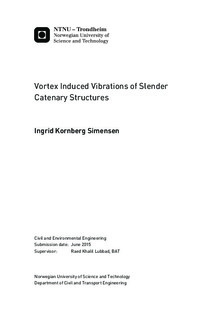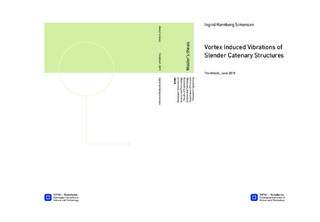| dc.description.abstract | A wide range of offshore science and engineering applications utilize slender catenary-shaped structural elements in their design. These applications include moorings and steel catenary riser designs. The susceptibility of these slender catenary-shapes to vortex-induced vibrations remains the subject of theoretical, numerical and experimental studies.
This thesis studies the measured responses from the 2001 MARINTEK experiment with the purpose of trying to understand the relation between analytical models, numerical models, and experimental measurements.
The time domain decomposition (TDD) method is implemented in a Matlab program, considering three velocity cases of cross-flow displacements in the catenary plane. The results show that in each of the cases, one of the frequencies has a higher degree of contribution than other frequencies. However, multiple frequencies are present throughout the measurements. Also, the frequencies corresponding to each mode varies. According to the MAC-criterion, the obtained mode shapes have a high degree of correlation with the numerically calculated mode shapes.
For verification of the TDD results, the poly-reference least squares complex frequency method and the data- and covariance-driven stochastic subspace methods of operational modal analysis (OMA) are used for studying the data in the commercial Matlab toolbox MACEC. As for the TDD method, the mode shape estimates have high MAC-values, and the corresponding natural frequencies vary. The damping estimates show a great amount of scatter. Also, there is a varying degree of certainty in the results according to result processing guidelines.
The effect of accelerometer masses and first order added mass effects are studied using a numerical model in Matlab. The effects of the masses are concluded to be negligible.
A comparison between the operational modal OMA obtained eigenfrequencies and the corresponding numerically calculated modes show a great amount of agreement in how the natural frequencies increase with mode number. However, for this case study, the analytical and numerical calculations appear to underestimate magnitudes of the frequencies. Also, there is an indication that the frequencies corresponding to each mode shape vary, possibly resulting from higher order added mass effects. | |

